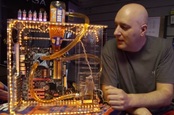This article is more than 1 year old
How'd your servers get that baby-smooth look? Dutch and Brit cool kids dunk Supermicro systems in synthetic oil
It's not Irn-Bru, but you can't have everything
Dutch liquid cooling specialist Asperitas and British systems integrator Boston have linked arms on a range of server systems based on "immersion cooling" – with the hardware submerged in giant tubs of synthetic oil, a dielectric compound very similar to Vaseline or baby oil.
Four fully contained standalone systems were presented at CloudFest in Rust, Germany, this week. Each is a tiny data centre in its own right – based on Supermicro servers and featuring thousands of CPU cores.
There's a choice of silicon from either AMD or Intel, and a high-density machine designed specifically for GPU workloads, full of Nvidia.
Asperitas designs enclosures for immersion cooling: horizontal server racks filled with dielectric coolant, which feature something that looks like a car bonnet as a cover. The company uses synthetic oil, which is much cheaper than proprietary dielectrics like 3M's Novec, used by some of its competitors. The coolant circulates thanks to natural convection and a secondary warm water circuit ejects the heat from the system; this heat can then be recycled, to keep the office warm, for example.
Immersive cooling can considerably increase the power density of IT, with Asperitas systems running at up to 22kW per "cabinet" as opposed to a 5-10kW average for traditional racks. However, due to their unusual footprint (600x1200mm), these systems are unlikely to serve as drop-in replacements for a standard 19-inch frame.
Such systems enable customers to squeeze more performance out of their CPUs by helping avoid thermal throttling – a hot system is a slow system. At the same time, the enclosure lowers the amount of energy spent on cooling – as there's no need to run server fans, air handlers, chillers and all the other wonderful equipment invented to stop IT kit from melting.
Another potential benefit is that, thanks to their self-contained nature, such systems can be deployed in any kind of building, in any climate – no data centre or dedicated server room required.
"Immersion cooling is not a goal for our customers, our customers have goals for their compute and cloud platforms and their business," said Maikel Bouricius, marketing manager at Asperitas.
"Immersed computing is a means to enable achieving these goals by cutting data centre service costs, accelerate operations, allowing for high performance applications and offering flexibility to reach for all business opportunities."
As for the specs, Fenway AIC24-DSI (aka CLOUDzone242) is a generic platform based on AMD's Zen silicon, namely EPYC 7000 series, with 1,536 cores, 48TB of memory and 960TB of storage.
Fenway AIC24-DST (CLOUDzone241) was designed to maximize compute density, with 96 CPUs and 3,072 Zen cores, 96TB of memory and 768TB of storage.
Fenway AIC24-DDW (CLOUDzone244) trades AMD chips for V4 series Xeons, with 1,056 cores, 48TB of memory and 960TB of storage on board.
And finally, Anna AIC (CLOUDzone243) is intended for GPU-based workloads like 3D rendering and machine learning – featuring the same 1,056 Xeon cores, but adding a whopping 331,776 CUDA cores across 72 integrated Nvidia cards.
The partners expect to present a high-density GPU compute solution specifically for AI applications later this year. ®


